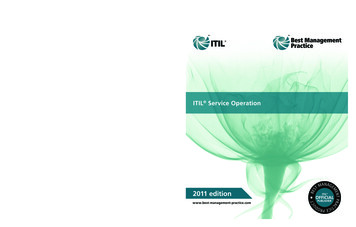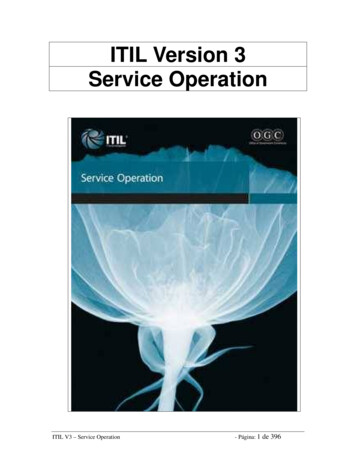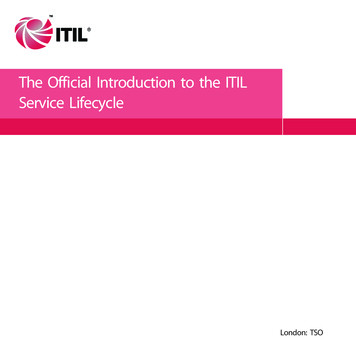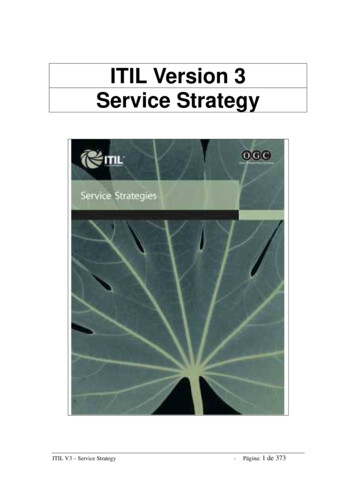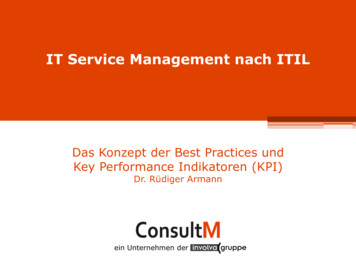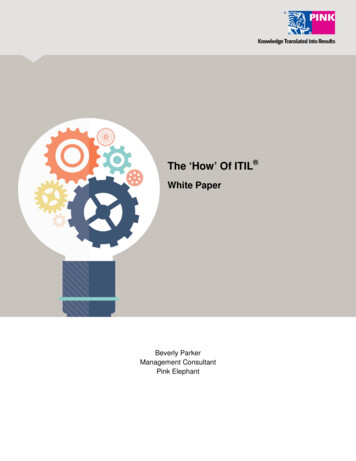
Transcription
The ‘How’ Of ITIL White PaperBeverly ParkerManagement ConsultantPink Elephant
The ‘How’ Of ITILThe ‘How’ Of ITILExecutive SummaryYour organization has begun its ITIL journey. You have invested in education so peopleunderstand what this thing called ITIL is all about, and perhaps some have gone beyondthe Foundation level to dig deeper into this framework of processes. There seems to besome really good stuff here, but the question everyone has is: “Just how do we go aboutimplementing this in your organization?”This is the same question that has been asked over and over again. For as long as ITILhas been around, it has been promoted as a framework for what you need to do, but theguidance for how to do it wasn’t really there. At least, that was the case until the releaseof the ITIL Practitioner Guidance book in 2016.Successfully implementing the ITIL processes requires more than simply designing orredesigning processes according to the ITIL guidance. There must also be a clearunderstanding of additional aspects of the initiative such as; the implications for theorganization; a structured approach for the implementation and the measurementsneeded; a plan for managing the people side of the changes; and the ‘what’, ‘when’ and‘how’ of appropriate communication with the stakeholders.Adopt & Adapt With The Guiding PrinciplesThe ITIL framework, as outlined in the five core books, describes the Service Lifecycleencompassing 26 processes and four functions and is recognized as a best practice forIT Service Management (ITSM). It is important to keep in mind that the implementationof part or all of the guidance is unique within each organization.The intent behind the ITIL guidance has never been for an organization to implementthe practices as documented in the books, but rather that it should be adopted and thenadapted to fit the needs of the organization.First, an organization must adopt and embrace a service mindset and culture, one thatis customer-oriented and focused on value delivery to its customers rather than thetraditional technology-focused organization of the past.Second, it is imperative that the organization not view the ITIL books as instructionmanuals but rather as best practice guidance that has underpinned the success ofmany IT organizations around the world. These organizations have adapted theguidance to fit their day-to-day practices for the delivery of IT services to theircustomers. Adapting these practices means choosing the elements that will help toimprove their ability to deliver value through services that facilitate the desired businesspinkelephant.comPage 2
The ‘How’ Of ITILoutcomes, modifying those elements as needed, and perhaps even ignoring some ofthe elements that don’t apply. Choose what works for you!The successful adoption of a service-oriented mindset and implementation of ITILpractices suited to an organization’s needs can be facilitated by embracing the nineguiding principles outlined in the Practitioner book. These principles should be appliedwhether you are undertaking a strategic service management initiative such as; theimplementation of ITIL practices across the organization; or looking for someoperational improvements, and whether you are a large or a small organization, andregardless of the industry sector in which you operate.Focus On ValueThis principle embodies the core of service delivery – its value as defined by thecustomer of the service. So what does this mean for your IT organization? It means thateverything you do must in some way contribute to the value expected by yourcustomers. This includes the processes you utilize, the infrastructure that supports theservices, improvements to those processes and services, as well as the implementationof ITIL practices.Dialog with customers is essential if you are going to truly understand what they value intheir IT services. This goes beyond the specific functional requirements and shouldinclude questions to clarify the business outcomes the customer is seeking, what’s mostimportant to them, and their preferences and perceptions regarding the services and theprocesses that support those services.Getting to know your customers at a deeper level, beyond simply their technologyneeds, will help ensure your service management improvement initiatives are focusedon value.Design For ExperienceIn addition to focusing on the value of your services and processes, you must alsoconsider the end-to-end experience of both the customers and the end users as this isthe basis of their overall satisfaction. As a provider organization, you must be able tostep into the shoes of your customers and users in order to understand their experiencewith your services. Look for the touchpoints with your customers and users and theexperiences that establish their ‘moments of truth’.It isn’t simply about a specific piece of hardware or software; but the combination oftechnology, processes and people that ultimately delivers the end-to-end experience.Look holistically at what happens and identify where the impact is negative orrepresents a pain point. What are your customers saying to you about the services?What are the end users expressing in terms of things that frustrate them? These shouldbe at the top of your list of improvements or your service management initiative.pinkelephant.comPage 3
The ‘How’ Of ITILStart Where You AreRarely is it necessary to scratch everything you are currently doing in favor of acomplete overhaul. There are likely to be some practices that may only need minorimprovement to achieve a higher value proposition. Look objectively at your currentpractices to see what can be leveraged as a starting point or foundation forimprovement in order to reduce the amount of effort to reach a desired future state.Also, consider other initiatives that are underway in which specific improvements mightbe included. This will help ensure similar work streams remain complementary to eachother.Leveraging what works today – what is currently fit for purpose and fit for use – canfacilitate the adoption of new or modified practices. Success will ultimately depend uponeffective organizational change management that addresses the people side of change,as noted later in this paper.Work HolisticallyWhether you are planning the implementation of ITIL practices or smaller improvementinitiatives, keep in mind that you need to consider the entire value chain, not simply theindividual parts. The delivery of IT services requires many different elements that spandifferent areas of the IT organization and an improvement in one area is likely to touchothers.Working holistically requires not only recognition of the different parts – the people,processes, products and partners – but also an understanding of their relationships,dependencies and interfaces. A holistic approach to improvement will also bedependent upon good collaboration – another guiding principle – across the entire ITorganization.Progress IterativelyNot only will you want to remember to start where you are, but also keep in mind thatyou need not tackle everything at once. Plan the initiative in smaller, more manageableefforts for more timely execution and the realization of value sooner than might bepossible with one large initiative.Smaller improvements can be easier to implement and easier for staff to adopt. Therewill likely be less resistance to smaller incremental changes which can help to build asense of accomplishment and confidence. When scoping these initiatives remember tofocus on the value proposition – whatever you plan must in some way deliver greatervalue to your customers.pinkelephant.comPage 4
The ‘How’ Of ITILProgressing iteratively mirrors the principles of Lean IT, the Agile methodology andDevOps. All of which advocate an approach of smaller, incremental efforts in order todeliver value sooner and faster.Observe DirectlyWhile measurements based on data will certainly be essential for your initiatives, data isnot a substitute for first-hand observation. Whenever possible, you should observe whatis happening and combine this with the data. Data will not necessarily present the entirepicture, thus the need for direct observation.This is another key principle of Lean methodologies; you must go to where the work isdone, referred to as a ‘Gemba walk’, talk with the people who do the work; ask ‘why’ touncover the reasoning behind the work being done. They can give you not only themost accurate understanding of the current state, but recommendations forimprovements as well.Be respectful of people’s time while observing, and practice active listening to clarifyunderstanding. Engaging with staff in this way can help to create a sense of trust whichwill foster greater cooperation as the initiatives proceed.Be TransparentShare information as early and as often as possible to make people aware of what ishappening, why it’s happening, and how. This will help prevent speculation,assumptions and rumors, and can help lower resistance to the changes. It will also helpto create a sense of urgency as noted by John Kotter in his eight steps for managingchange.Utilize ITIL’s concept of the CSI register to make people aware of the improvements bymaking it visible to everyone. Plan to address the needs of staff and management withappropriate, timely communications, and remember to also communicateaccomplishments along the way.CollaborateCollaboration – getting the right people involved in the right way at the right time – willresult in better buy-in for your initiatives and improve the likelihood of success.Cooperation and collaboration with a focus on shared goals can ensure differentperspectives and insights are considered and addressed.Identify the different stakeholder groups that span not only the IT organization but alsocustomers, users and even suppliers. Recognize that not all stakeholders will need tobe engaged at the same level of detail, so scoping the collaboration based upon theinterest in or impact of the initiative should be taken into account.pinkelephant.comPage 5
The ‘How’ Of ITILEffective collaboration will help to ensure support among the stakeholder groups,ultimately leading to higher chances of adoption and success.Keep It SimpleStrive to keep things as simple as possible. If activities provide no real value, theneliminate them. If they are necessary, for example to ensure compliancy with legal orregulatory requirements, then look for ways to streamline by removing or simplifyingsteps. Eliminate unnecessary bureaucracy and create simple procedures or workinstructions.Collaboration with others, creative thinking and challenging the ‘old ways’ of doingthings can often result in simpler ways of carrying out the work. In the end, everyonebenefits.Use The Continual Service Improvement (CSI) ApproachThe six-stage CSI Approach as documented in the ITIL CSI publication provides astructured approach for managing the implementation of ITIL practices or any other typeof improvement initiative. By embracing the concepts of the Plan-Do-Check-Act (PDCA)cycle, this approach ensures improvements are aligned to the strategic vision of theorganization and the value proposition for your customers.What Is The Vision?Before beginning any type of initiative, it’s critical to ensure it aligns to the overall vision,goals and objectives of the IT organization and subsequently to those of the business.Creating a vision for the initiative will help in communicating its direction and purpose tothe stakeholders and the value that is expected from it.Where Are We Now?While it may be tempting to move forward with improvements, the current state mustfirst be established as a starting point. Performing an assessment of the currentpractices will enable the provider to more clearly define the desired future state and willestablish the baseline for later comparison following the implementation of theimprovements.Where Do We Want To Be?Establishing future measurable targets after assessing the current situation allows for agap analysis to identify the appropriate objectives and specific improvements that willmove the organization toward the future state. This will facilitate the identification ofappropriate critical success factors and key performance indicators (KPIs) aligned to thepinkelephant.comPage 6
The ‘How’ Of ITILoverall vision, goals and objectives for the initiative, and will aid in the prioritization ofthe improvements.How Do We Get There?A plan for implementing the improvements identified in the previous stage can now bedefined and executed. Remember to consider the guiding principles as you begin theplanning and if appropriate, incorporate project management approaches for managinglarger initiatives. Also, keep in mind that breaking larger initiatives into smaller ones canhelp lower resistance, increase adoption and lead to more successful change.Effective communication and ongoing stakeholder management are critical prior to andthroughout the implementation of the improvements. Measurements defined for thefuture state should be used during the implementation to ensure progress in the rightdirection is being made and to enable corrective actions if needed.Did We Get There?Using the measurements defined previously along with input from the stakeholders, youcan now determine if the defined future state was achieved. A benefits realizationreview can be carried out to confirm achievement of or at least progress toward the newstate. Present the results to the stakeholders and confirm that the expected value hasactually been realized.How Do We Keep The Momentum Going?As noted earlier, the PDCA cycle is the basis for continual improvement and the CSIapproach means you keep going. What comes next? If you didn’t reach the desiredfuture state then perhaps a second iteration is needed, or perhaps you are ready tomove on to a different initiative.You must also ensure the benefits received as a result of this
The six-stage CSI Approach as documented in the ITIL CSI publication provides a structured approach for managing the implementation of ITIL practices or any other type of improvement initiative. By embracing the concepts of the Plan-Do-Check-Act (PDCA) cycle, this approach ensures improvements are aligned to the strategic vision of the






